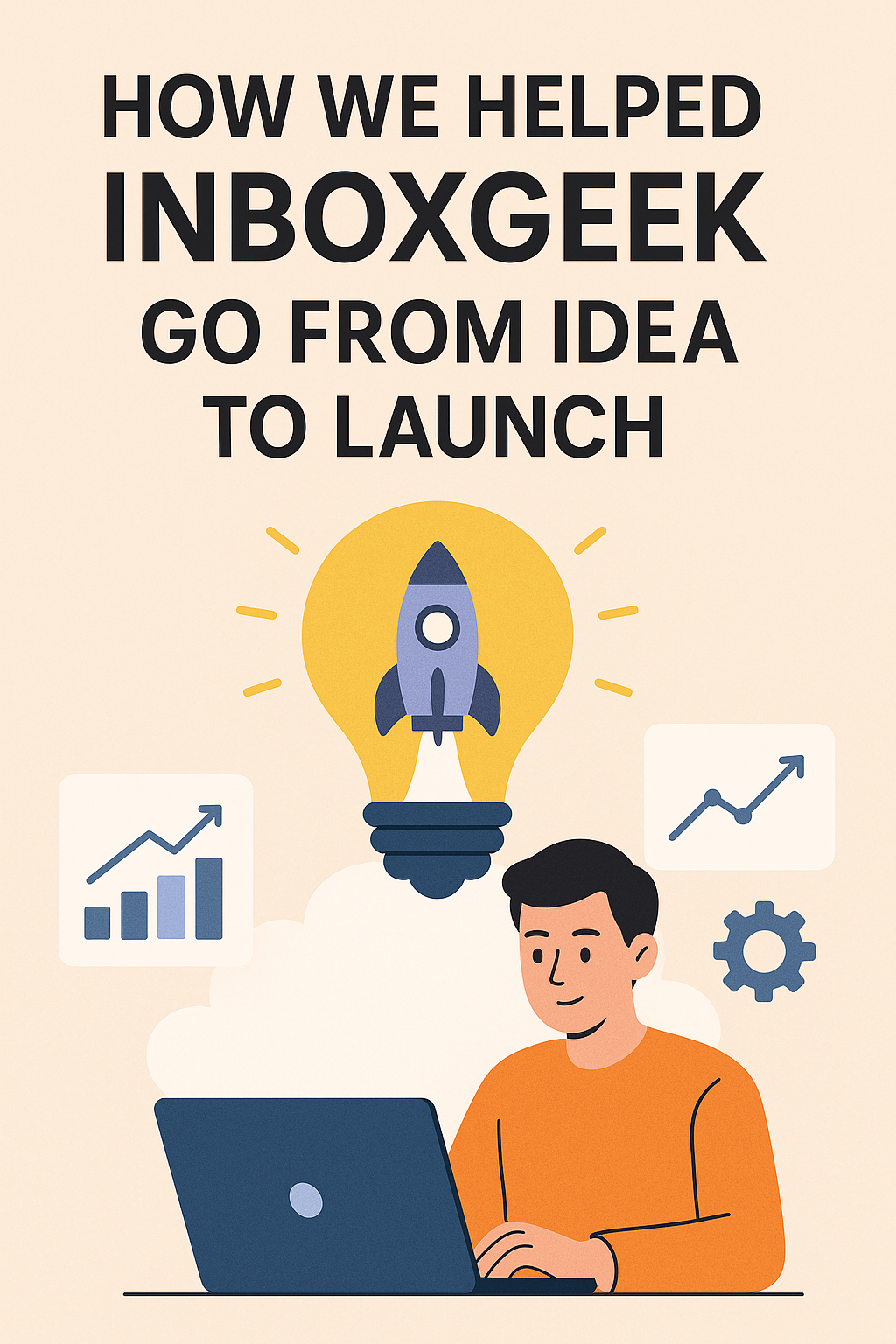Introduction: Turning a Vision into a Scalable Product
Inboxgeek started as a simple but bold idea: help creators and startups send smarter emails, faster. The founder had a clear vision, but no tech team. No code. No product. Just insight, energy, and ambition.
Our mission? Turn that vision into a product—fast. In this article, we’ll walk through how we helped Inboxgeek go from idea to launch, with a functional MVP, real users, and a clear growth path in under 90 days.
About Inboxgeek: The Challenge and Opportunity
Understanding the Founder’s Vision
The Inboxgeek founder came to us with a pain point: traditional newsletter tools were clunky, over-complicated, and not optimized for growth. What users really needed was an elegant, opinionated way to build email lists and convert subscribers—without spending hours in a builder.
The Problem Space: Email Newsletters and Engagement
Despite hundreds of email tools, few were built specifically for fast-moving creators and early-stage marketers. Inboxgeek aimed to solve this by offering:
- A dead-simple campaign builder
- Smart defaults (so users don’t need to configure everything)
- Real-time feedback on how messages perform
Market Gaps and User Frustrations
We analyzed competing products and noticed the same feedback over and over:
- “Too many settings.”
- “I just want to send an update fast.”
- “This doesn’t scale well with a small team.”
That was our entry point.
Stage 1: Discovery and Product Planning
Workshops to Define the MVP Scope
We kicked things off with discovery sessions to understand:
- What core jobs users needed to do
- What could wait for later
- How we could deliver value fast without bloat
Audience Personas and JTBD Mapping
We created three key personas:
- Indie Creator
- Startup Marketer
- Non-technical Business Owner
Each had similar goals: send, track, and grow email engagement—without friction.
Feature Prioritization and Roadmap Design
We scoped the MVP to include:
- Campaign creation
- Smart lists
- Email performance tracking
- Basic automation triggers
Everything else went into the “v2” bucket.
Stage 2: Designing for Focus and Simplicity
UI Principles and Brand Alignment
We knew early on that ease of use would be the brand. So we leaned into:
- Clean, minimal interfaces
- Consistent, friendly UI patterns
- A focus on clarity over customization
Prototyping the Core Flow: Campaign Creation
We rapidly prototyped the main campaign builder and tested it with 5 creators. Feedback? “This is refreshingly simple.”
Mobile-First Considerations for Creators on the Go
While newsletters are often desktop-built, many Inboxgeek users wanted to check stats or send updates via phone. So we optimized the dashboard for mobile.
Stage 3: Rapid MVP Development
Tech Stack Decisions: Laravel + Vue.js
To balance speed and flexibility, we used Laravel (for its rich ecosystem) and Vue.js (for reactive, smooth UI interactions).
Sprints, QA Cycles, and Weekly Demos
We ran weekly sprints with live demos to the client. Each sprint delivered a working feature—and allowed time for feedback and refinement.
Iterating with Feedback from Real Users
By sprint 3, we had a working campaign flow. We brought in beta users to test it, uncover edge cases, and prioritize polish over perfection.
Stage 4: Go-to-Market Strategy and Launch
Pre-launch Landing Page and Early Access Funnel
We helped the Inboxgeek team launch a waitlist-driven landing page with messaging, benefits, and teaser UI shots—capturing over 600 leads before the MVP was live.
Beta Launch Metrics and Learnings
Once launched:
- 140 beta users activated
- 60% sent at least one campaign
- Most common praise: “I didn’t have to think—I just sent.”
Scaling to a Broader User Base
With stable infrastructure and positive user feedback, Inboxgeek moved quickly into refining onboarding, adding help docs, and preparing for paid plans.
Outcomes: What Inboxgeek Achieved Post-Launch
User Growth, Engagement Rates, and Feature Adoption
In the first month post-launch:
- 1,200+ emails sent
- 35% weekly active users
- 2.3 campaigns per user on average
Key Metrics That Proved Product-Market Fit
The signs were clear:
- Users were inviting friends
- Support requests were minimal
- Feedback was asking for more—not different
Feedback Loop and Continuous Improvement
Every feature request was tracked. Every support query became a user story. Inboxgeek built with users—not for them.
Lessons Learned from the Project
The Power of Small, Focused Teams
With just a PM, designer, and two devs, we delivered more in 12 weeks than many startups manage in a year.
Why Rapid Feedback Beats Assumptions
Prototyping early saved us from building features users didn’t need—and helped us double down on what mattered.
The Value of Launching Before You’re “Done”
Inboxgeek launched with a lean feature set—but the right one. That let them start learning, not just building.
Conclusion: Building With Speed, Purpose, and Partnership
Inboxgeek is proof that with the right process, tools, and mindset, you can take a raw idea and turn it into a living, breathing product in months—not years.
At Codelabs, we don’t just write code—we build partnerships, clarify strategy, and move with urgency. If you’ve got an idea worth building, we’d love to help bring it to life—just like we did with Inboxgeek.
FAQs About Inboxgeek and Codelabs’ Role
1. How long did the MVP take to launch?
Just under 90 days—from strategy to working product.
2. What was the tech stack?
Laravel for backend, Vue.js for frontend, and TailwindCSS for UI components.
3. How involved was the founder during the build?
We worked closely with the founder weekly—sharing demos, feedback, and strategy updates.
4. Did Inboxgeek have users before the product existed?
Yes! We launched a pre-launch page and grew an early access list of 600+.
5. What’s next for Inboxgeek?
They’re adding integrations, analytics features, and refining their onboarding.
6. Can you help me build something like this?
Absolutely—whether you’ve got a rough idea or a Figma file, we’re ready to help you bring it to life.

